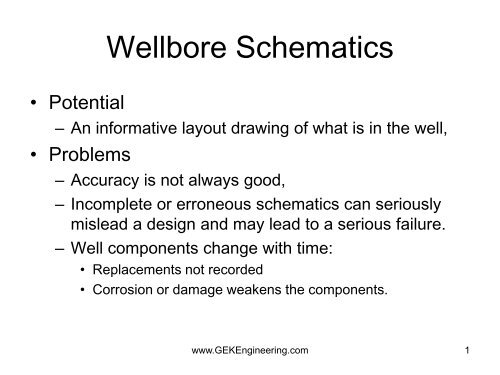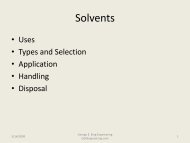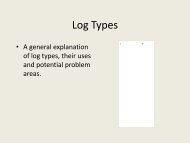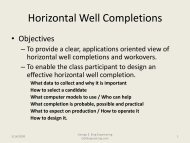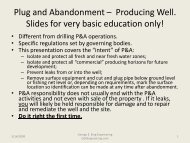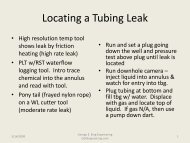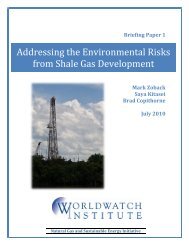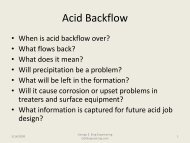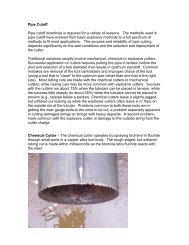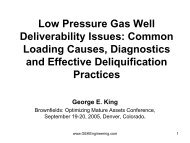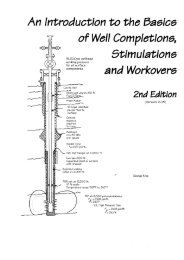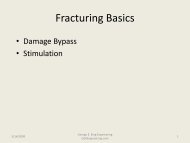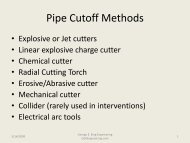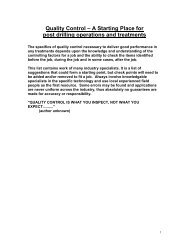Reading a wellbore Schematic
Reading a wellbore Schematic
Reading a wellbore Schematic
- No tags were found...
Create successful ePaper yourself
Turn your PDF publications into a flip-book with our unique Google optimized e-Paper software.
Wellbore <strong>Schematic</strong>s• Potential– An informative layout drawing of what is in the well,• Problems– Accuracy is not always good,– Incomplete or erroneous schematics can seriouslymislead a design and may lead to a serious failure.– Well components change with time:• Replacements not recorded• Corrosion or damage weakens the components.www.GEKEngineering.com 1
Example <strong>Schematic</strong> – sub sea wellWhat information is available on new well?1. Pipe size, end of the string.2. Location of restrictions.3. Deviations, dog legs4. Overlaps5. Shoulders6. Pay7. Fluid behind the pipe8. Other BHA9. Damage locations?But that’s not all the information that isthere.www.GEKEngineering.com 2
Header InformationWELL TYPE: OIL PRODUCER RTE: 29m MAX DOGLEG: 6.184 deg @ 1725mFIFST COMPLETED: 22/12/96 SWAB: MAX DEVIATION: 89 deg @ 4456MWORKOVER DATE: MAY 2001 KOP: 2290M AV. ANGLE THRU PAY: 88 deg.WORKOVER NO: 1 HUD: MINIMUM I.D.: 4.060 @ LTVANN. FLUID: CaCl 2 BRINEDEPTH UNITS: METRESFLUID WT: 1.17 SGREF. LOG: XXXXXwww.GEKEngineering.com 3
Components – size, grade, id, positionwww.GEKEngineering.com 5
www.GEKEngineering.com 6
FlangesNominalSize ofFlangeCasing SizeDiameter ofFlangeDiameter ofBoltCircleNumber ofBoltsRing Type2-1/16 2-3/8 8-1/2 5-1/2 8 R-242-9/16 2-7/8 9-5/8 7-1/2 8 R-273-1/8 3-1/2 11 8-1/2 8 R-374-1/16 4-1/2 12-1/4 9-1/2 8 R-385-1/8 5-1/2 14-3/4 11-1/2 8 R-447-1/16 7 15-1/2 12-1/2 12 R-4611 9-5/8 23 19 12 R-5413-5/8 16 30-3/8 26-5/8 16 BX-1605000 psi, Type 6Bwww.GEKEngineering.com 8
Profileswww.GEKEngineering.com 10
Pay Interval <strong>Schematic</strong>1. Where are the fluid entry points1. From the <strong>wellbore</strong>2. From the reservoir.2. Will the interval between the sceens packduring gravel packing?3. Will ECP’s inflate? How long is the slide?How rough? What deviation? What fluid isuse to inflate? What is the stability andpermeability of the set point?www.GEKEngineering.com 11
Limited <strong>Schematic</strong>sArtists renditions – too much missing.Problems in a deviated well arise around kickoff points (windowdebris, sharp edges, doglegs), build angle, junction isolation qualityand changes in angle along the horizontal plane.www.GEKEngineering.com 12
Completions Section – What arethe clearances, hot spots, entries, etc.www.GEKEngineering.com 14
What is below the currentcompletion may influencewhat can be done in aworkover.Plug qualityLeak potential from highpressure gas or waterzones.Corrosion potential of lowerzoneswww.GEKEngineering.com 15
Upper section of a dual, note packer,15a1515awww.GEKEngineering.com 16
Bottom zone of a dual completion with sand control. Note clearances, screen location with respectto pay, isolation potential, method of stacking the completion, and opportunities for problems.www.GEKEngineering.com 17
Another style of well boreschematic.Note that the level of detail isdifferent – not as muchinformation on the individualjewelry.Note that the I-1 uppercompletions is a sand controlcompletion with the longstring passing through ascreen. This needs a blastjoint to protect against longstring leaks and failure.Good isolation in most cases.The I-5 Sand is a nonperforatedfuture alternativepay. In this configuration,how could it be completed?Note how the completion isseparated, allowing packingof the L-4 and then buildingthe upper completions.www.GEKEngineering.com 18
Gas Lift Valve Locations:DepthSize?Dummied or Active?Condition?www.GEKEngineering.com 19
Red Flags - Restrictions• In the design/drill– Profiles– Some connections– Crossovers– SSSV’s– Doglegs– Deviated sections• Production– Scale– Organic ppts.– Salt– Tubular deformation– Fish– Fillwww.GEKEngineering.com 20
Workover Concerns• Tubing end – entry of tool strings• Latching plugs and fish– Deviated set points– Fill• Swell of elastomers on plugs• Swell and bow in fired perforating guns• Overlap sections for perforating• Liner tops (leaks)• How to circulate out the back side.www.GEKEngineering.com 21
Common Mistakes and Errors• <strong>Schematic</strong> not current:– Last redesign, workover, failure not listed.– Corrosion, fill, collapses, or fish not listed.– Does pipe/wellhead need to be derated?– Deviation shortens tool length that will run through thebend.• So, how do you know what’s there?– Drift / tag, bailer, dummy tool runs, impression blocks,camera…– Talk to the field and last engineer who had the well.www.GEKEngineering.com 22


